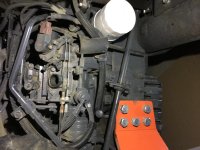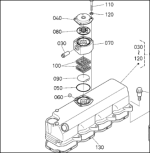I知 new to the forum, and would like to post a question. I have a 2010 Kubota Grand
L5740. It has just over 200 hours on it. I live in Iowa, and it has been very cold lately, sub 0 temps. Today, I pulled the tractor out to clear my driveway, and to move some wood. The tractor started and ran fine, I used it for maybe 20 min, and then parked it. I went back outside a couple hours later, started it, and put it back in the barn. I noticed when I got out, that it had a pretty good amount of oil leaking from underneath. When I got it inside, I crawled underneath, and saw that oil was leaking out of where the dipstick tube enters the case. I also noticed that the oil fill cap had blown off. I went inside to look some stuff up, and went I went back to check in it, it appears that oil is being blown out of my exhaust pipe. I did start it up again, and it started fine, and idled fine. Could it be a frozen pcv valve? Is there even one on this tractor. I知 clueless. Any thoughts or help is appreciated.
Jesse
Welcome to TBN, Jesse.
Yep, those are classic signs of a frozen PCV valve. Your Grand
L5740 and my
M59 use the same engine - and same transmission, I believe. So they probably use a similar or same device for Positive Crankcase Ventilation.
That problem of PCV valves freezing in very cold weather has been around since PCV valves were invented. And it is a known problem with Kubotas which has been written about on TBN before now. It can happen to any engine in in real cold weather if the motor isn't working hard enough to get warm. You might want to tie a string to the oil dipstick so that if it blows out you can find it again.....no, I'm not kidding. It hasn't happened to me, but I recall someone posting about it.
The good news is that this pressure in the crankcase in cold weather is a known problem and probably not anything serious - but you should vent it to protect the engine seals.
Some history: Before PCV valves, crankcase ventilation was simply vented via a tube directly into the open air. You can still do that if you wish. Be aware that a direct vent pollutes the atmosphere with oil/water vapor and is a path for contaminents back into the engine. Both of those problems were mitigated 50 years ago by running the vent tube into a "breather cannister" instead of routing the vented fumes back into the intake manifod as is common today. The breather cannister was basically a tin can filled with a metal fiber filter material that became very oily. The water vapor evaporated away.
The PCV valve on your engine is hopefully like other Kubotas and consists of a gizmo mounted right in the middle of the valve cover. In fact, the valve body should be the next & only thing rearward of the oil fill cap right there on top of the valve cover. You should see a hose or tube connected to it. The problem is condensation freezing - just as you suspected. The engine doesn't get things hot enough. Removing 4 bolts on the top of the PCV body gives you access to a spring and diaphram that are the heart of the PCV itself. That's probably where it is frozen up, although there is some chance that some condensation at a low point in the breather hose has made an ice blockage in the hose.
If you change the existing system, take a moment to think about which way the pressures are going. At certain RPMs combined with certain coolant temperature the turbo pressurizes the intake manifold via the EGR valve - that needs to be considered.
I guess you could try to heat the PCV valve or tape some insulation over it so that the engine would heat it more.
Or you could just poke a hole in the oil filler cap and run a hose from that cap into a home-made breather cannister. Instant old style venting.
I haven't done anything to our
M59 because we haven't had that freezing problem, probably because our winters here in the Rocky Mountains have been fairly mild since we got the
M59. Some people say global warming....but I don't know if that's it. I do know that warmer winters with hardly any snow have become the norm here in the last decade.
Good Luck,
rScotty


